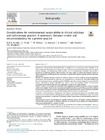| dc.contributor.author | Anudjo, Messiah | |
| dc.contributor.author | Vitale, C. | |
| dc.contributor.author | Elshami, W. | |
| dc.contributor.author | Hancock, A. | |
| dc.contributor.author | Adeleke, S. | |
| dc.contributor.author | Franklin, J. M. | |
| dc.contributor.author | Akudjedu, T. N. | |
| dc.date.accessioned | 2024-01-16T15:51:21Z | |
| dc.date.available | 2024-01-16T15:51:21Z | |
| dc.date.issued | 2023-10 | |
| dc.identifier.citation | Anudjo, M. N. K., Vitale, C., Elshami, W., Hancock, A., Adeleke, S., Franklin, J. M., & Akudjedu, T. N. (2023). Considerations for environmental sustainability in clinical radiology and radiotherapy practice: A systematic literature review and recommendations for a greener practice. Radiography, 29(6), 1077-1092. https://doi.org/10.1016/j.radi.2023.09.006 | en |
| dc.identifier.issn | 1078-8174 | |
| dc.identifier.uri | https://aecc.archive.knowledgearc.net/handle/123456789/239 | |
| dc.description | Available under License - Creative Commons Attribution: https://creativecommons.org/licenses/by/4.0/ | en |
| dc.description.abstract | Introduction: Environmental sustainability (ES) in healthcare is an important current challenge in the wider context of reducing the environmental impacts of human activity. Identifying key routes to making clinical radiology and radiotherapy (CRR) practice more environmentally sustainable will provide a framework for delivering greener clinical services. This study sought to explore and integrate current evidence regarding ES in CRR departments, to provide a comprehensive guide for greener practice, education, and research.
Methods: A systematic literature search and review of studies of diverse evidence including qualitative, quantitative, and mixed methods approach was completed across six databases. The Preferred Reporting Items for Systematic Review and Meta-Analysis (PRISMA) guidelines and the Quality Assessment Tool for Studies with Diverse Designs (QATSDD) was used to assess the included studies. A result-based convergent data synthesis approach was employed to integrate the study findings.
Results: A total of 162 articles were identified. After applying a predefined exclusion criterion, fourteen articles were eligible. Three themes emerged as potentially important areas of CRR practice that contribute to environmental footprint: energy consumption and data storage practices; usage of clinical consumables and waste management practices; and CRR activities related to staff and patient travel.
Conclusions: Key components of CRR practice that influence environmental impact were identified, which could serve as a framework for exploring greener practice interventions. Widening the scope of research, education and awareness is imperative to providing a holistic appreciation of the environmental burden of healthcare.
Implications for practice: Encouraging eco-friendly travelling options, leveraging artificial Intelligence (AI) and CRR specific policies to optimise utilisation of resources such as energy and radiopharmaceuticals are recommended for a greener practice. | en |
| dc.language.iso | en | en |
| dc.publisher | Radiography | en |
| dc.subject | Radiology | en |
| dc.subject | Climate change | en |
| dc.subject | Environmental sustainability | en |
| dc.subject | Green radiology | en |
| dc.subject | Systematic review | en |
| dc.title | Considerations for environmental sustainability in clinical radiology and radiotherapy practice: A systematic literature review and recommendations for a greener practice | en |
| dc.type | Article | en |
| dc.identifier.doi | https://doi.org/10.1016/j.radi.2023.09.006 | |
